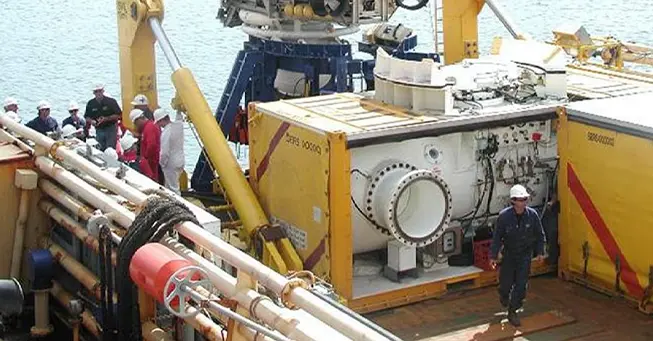Heerema Sleipnir contract to TMC Compressors
The scope of work includes manufacturing and delivery of a complete marine compressed air system,...
How do you safely decompress a complete 72-person crew of a distressed submarine? That was the challenge Australian H.I.Fraser’s Engineering Consulting group was tasked to solve on behalf of the Royal Australian Navy’s Submarine Escape and Rescue Service (SERS).
The Royal Australian Navy’s SERS includes a containerised hyperbaric suite which consists of two deck decompression chambers that are connected to a transfer-under-pressure chamber.
As one part of a bigger delivery, H. I Fraser’s was responsible for the design, supply, DNV certification and testing of a containerised (30 foot long), transportable screw compressor and distribution board module, to distribute breathable blowdown air and power to the hyperbaric suite.
To be able to safely decompress a submarine crew, two of the most critical services to the hyperbaric suite are clean, pressurised air and power. To help provide this, H.I. Fraser’s contracted TMC to supply 2 x 54 kW oil-lubricated air compressors as well as 2 x desiccant air dryers and filter combination.
“With numerous people locked in a decompression chamber for several days, the ability to deliver pressurised, dry and clean air suddenly becomes a matter of life and death. This was a brutal reality check, but it also helped underline the importance of delivering a top quality system,” says Hans Petter Tanum, TMC’s director of sales and business development.
When atmospheric air goes through a compressor, the air volume is reduced but the air still contains the same amount of impurities and water as the original air volume. That is why you need dryers and filters to achieve the highest air quality.
TMC therefore supplied two seawater-cooled, high flow, low pressure, oil-lubricated screw compressors and two desiccant dryers to provide 100 percent redundancy in the breathing quality pressurisation air to the hyperbaric suite. Continuous local and remote monitoring of the delivered air purity ensures compliance with the requirements of DNV rules, Australian Defence specifications and AS/NZS 2299.
“There is a widespread belief that only oil-free compressors can produce oil-free air. That is incorrect. Impurities, such as oil, dust, particles and humidity, are normally a result from the ambient air on board a vessel – not from the compressor alone.
“The only way to obtain clean, oil- free air is through proper filtration, regardless of whether the compressor is oil-free or oil-lubricated. Therefore, the well proven TMC package with air compressors, air dryers and filters was successfully chosen and provided to fit the needs of the SERS hyperbaric suite,” says Tanum.
On 7 October 2016, H.I.Fraser was announced as Winner in Innovation, Research and Development category of The Australian Engineering Excellence Awards (AEEA) Sydney 2016.
“This was a fantastic project to be involved with. H.I. Fraser has, deservedly, won a number of awards for their efforts. We like to think that we have played a small but important part in a fairly ground-breaking project,” Tanum adds.
Source: www.hifraser.com.au
The scope of work includes manufacturing and delivery of a complete marine compressed air system,...
8 December 2021 – TMC Compressors (TMC) has been chosen to supply a large marine compressed air...
Shanghai Zhenhua Heavy Industries Co., Ltd. (ZPMC) has placed a substantial order with TMC...
